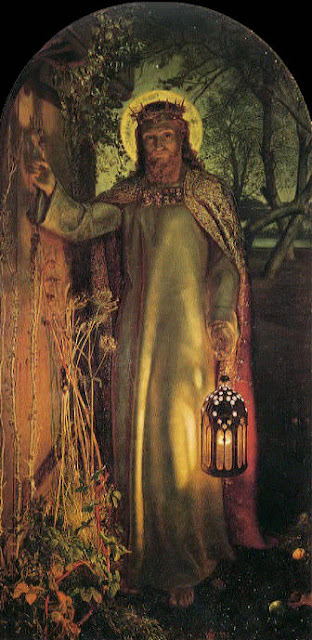I thought that this day of Epiphany - the day we celebrate the coming of the light of Christ to the Gentiles - would be a suitable day to consider and enjoy this 19th century painting by William Hunt, who envisioned this scene while meditating on Revelation 3:20: "Behold, I stand at the door, and knock: if any man hears my voice, and opens the door, I will come in to him, and will sup with him, and he with me."
To express his vision, Hunt used objects with profound meaning and symbolism. He painted a night scene of an orchard, an analogy of the sleeping soul. The orchard represented the nourishment available to the soul. Ripened apples ready for harvest, are depicted in the lower right side of the picture. A bat flitting around in the darkness symbolizes ignorance.
As a model for Christ's face, Hunt chose a woman for gravity and sweetness of expression. But for the figure of Christ, he used a male model. Christ's jeweled robe and breastplate depicted his royal and priestly role and his reign over the body and soul that give allegiance to him. Hunt searched for a suitable material from a local linen draper for Christ's robe, but finally used a tablecloth altered by a tailor. It was white, symbolizing the Holy Spirit within.
A metalworker formed the heptagonal, domed lantern that served as a model for Hunt. Truth, symbolized by the lamp, shines despite obstacles. A closed rusty-hinged door represents the obstinately shut mind; the weeds suggest that the person inside has failed to look for truth. Christ is the bearer of light to the sinner behind the door. There is no handle on the door, because the human heart must be opened by the person inside.
In 1853, Hunt finished the painting he had envisioned and it was displayed in the Royal Academy in London. At first, religious viewers disliked the painting because they thought it reprehensive that Christ would be shown carrying a lantern. Christ IS The Truth, not merely the bearer of the truth, some thought. But they misinterpreted what Hunt had attempted to communicate. Art critics of the day also objected to the painting, particularly because its color scheme was heavy and opaque.
It wasn't until John Ruskin, an influential art critic, wrote to the London Times, that the painting gained acceptance. He defended and explained the painting -- "I believe there are a few persons on whom the picture, justly understood, will not produce a deep impression. For my own part, I think it is one of the noblest works of sacred art ever produced in this or any age."
for the historical information about and interpretation of this painting.

1 comment:
Thanks for sharing this. I like the painting, even more so with the explanation.
Post a Comment